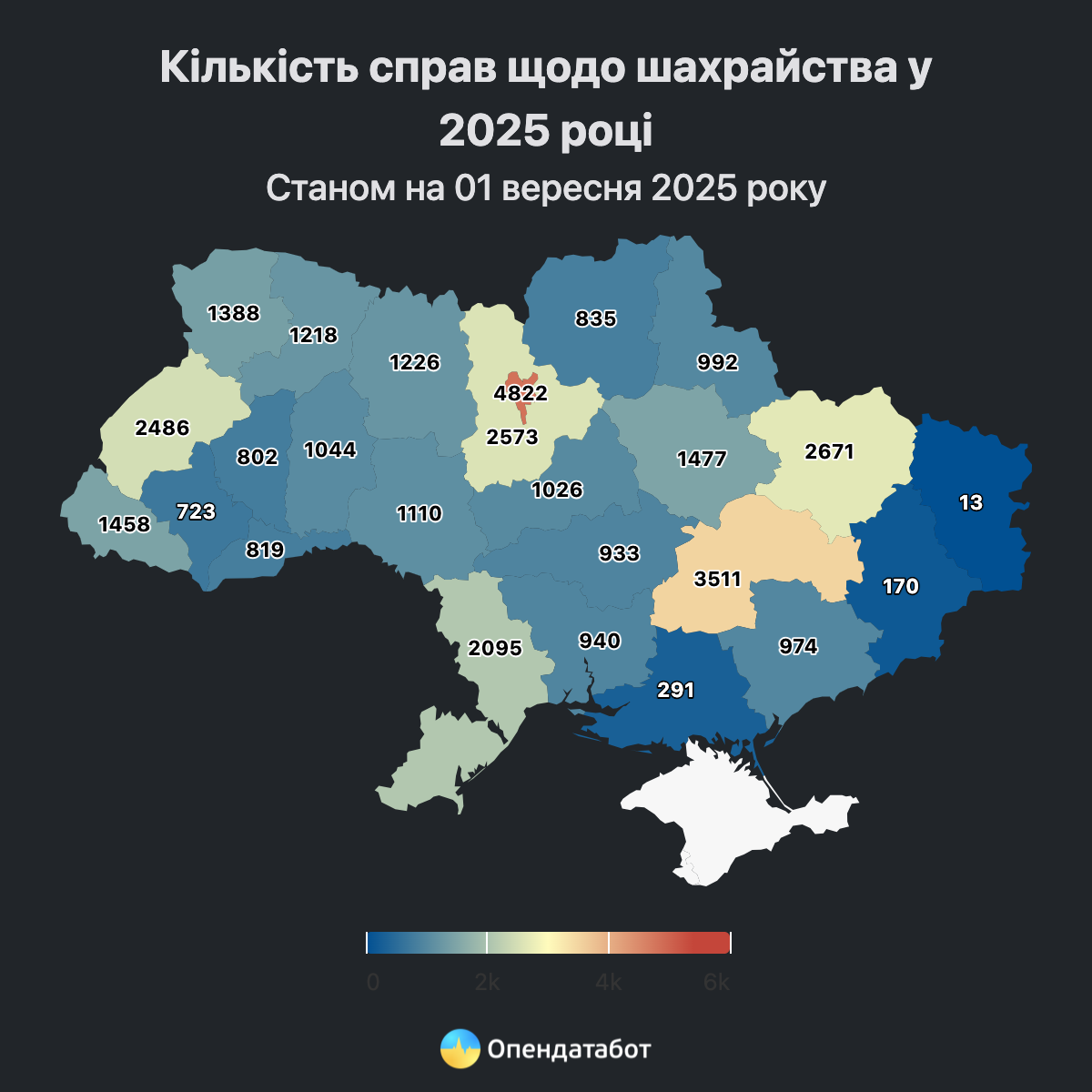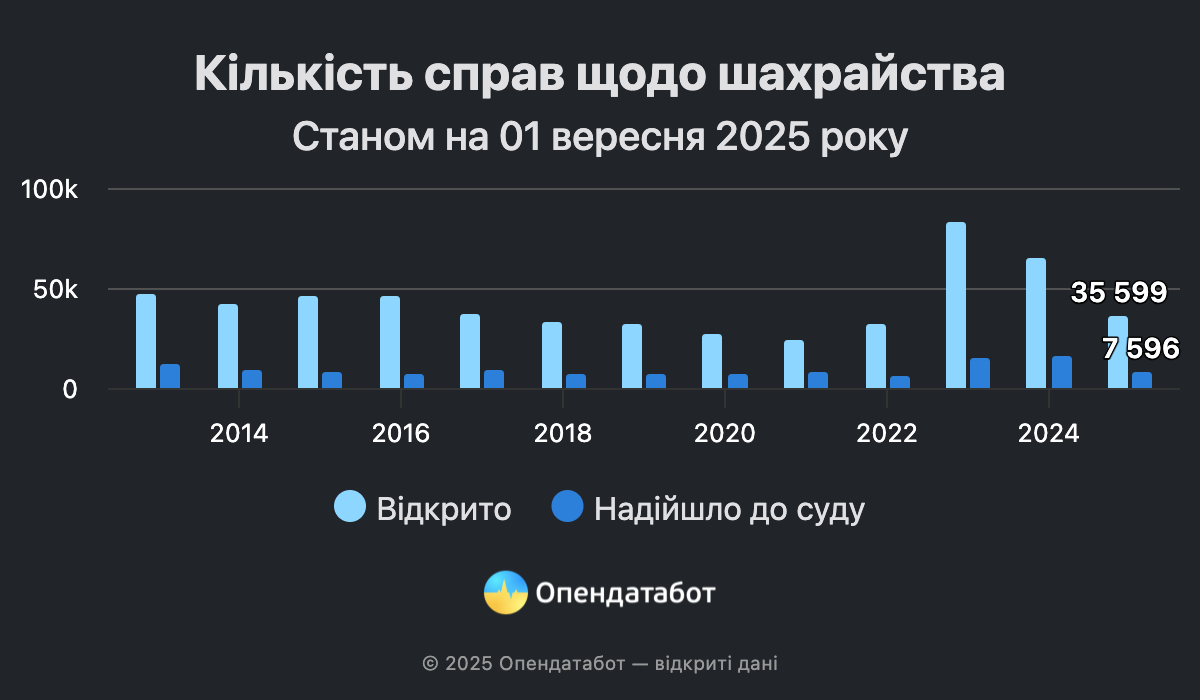
Every fifth proceeding reaches court
According to the Prosecutor General’s Office, over 35,000 criminal proceedings under Article 190 of the Criminal Code of Ukraine, “Fraud,” were opened in the first eight months of 2025. This is 1.5 times less than in the same period last year, but 1.8 times more than in 2021. On average, 4,500 fraud cases are opened in Ukraine every month. Currently, most proceedings are opened in Kyiv, Dnipropetrovsk, and Kharkiv regions. 21% of cases reach court.
35,599 criminal cases of fraud were recorded from January to August 2025 in Ukraine. This is 1.5 times less than during the same period last year. At the same time, it is still 1.8 times more than before the start of the full-scale war.
The peak of fraud occurred in 2023, when a record 82,000 cases were opened. On average, 7,000 cases were opened each month that year, and from May to August, more than 8,000. Since then, the number of new cases has been gradually decreasing. This year, about 4,500 new cases are being filed per month.
However, not all cases reach court. Thus, in 9,000 cases this year, suspects were charged, and 7,600 cases were sent to court — 21% of the total number. For comparison, in 2021, this figure was 30%, and in 2022–2023, only 18%.
The capital has seen the most reports of fraud this year, with 4,882 cases. This is followed by Dnipropetrovsk region with 3,511 cases and Kharkiv region with 2,671 cases. The lowest number of cases, except for the temporarily occupied territories and the combat zone, was recorded in Ivano-Frankivsk region — about 700 cases.
Overall, the number of fraud cases this year has decreased by a third compared to last year. However, in some regions, the decline is minimal, such as in Khmelnytskyi region, where the figure has decreased by only 1%. In contrast, in Dnipropetrovsk and Chernivtsi regions, such reports have decreased by more than 40%.
However, compared to 2021, the number of fraud cases in Zhytomyr region has increased more than fourfold, and in Zakarpattia region – threefold.
https://opendatabot.ua/analytics/fraud-2025-8



The European Bank for Reconstruction and Development (EBRD) will provide a long-term secured loan of EUR11 million to Karpatski Mineralni Vody LLC (KMV) from the group of the same name to finance the construction and commissioning of a new beverage production plant with an effective capacity of 200 million bottles per year in the Lviv region.
“The use of modern equipment at the new plant will significantly increase resource efficiency compared to the existing plant. The project will increase the Group’s competitiveness, production efficiency, and environmental performance,” the bank said on its website.
According to the information, the EBRD Board of Directors approved the loan on August 5, and the next step will be the signing of the necessary documents.
It is noted that the total cost of the project is EUR24 million.
KMV LLC is a manufacturing company of the KMV Group, one of Ukraine’s leading producers of non-alcoholic beverages, producing mineral water, flavored mineral water, other non-alcoholic and energy drinks, as well as snacks, the EBRD noted.
According to the project, the group will have to conduct a comprehensive hydrogeological study during the first three years of operation to assess the permissible volume of water intake for the future, as well as ensure automatic monitoring of water intake and groundwater levels at its wells.
The project provides for a first loss guarantee provided by the European Union through the Ukraine Investment Framework (UIF), and the costs of external pre-investment legal and environmental and social analysis will be partially covered by the Japan-EBRD Cooperation Fund.
In addition, KMV is expected to receive a grant under the EBRD’s Human Capital Investment Incentive (HCII) program to cover up to 50% of eligible costs related to improving workplace accessibility and upgrading equipment and infrastructure. It is expected that the grant funds will be allocated from the Japan-EBRD Cooperation Fund or provided by a Taiwanese donor. The project is also expected to receive a FINTECC grant under the EU4Climate program for the purchase of energy-efficient bottling equipment.
According to data from YouControl, KMV LLC increased its revenue by almost 2.3 times in the first half of 2025, to UAH 277.20 million, and its net profit by 8.2 times, to UAH 140.69 million.
The beneficiaries of the company are listed as Serhiy Petrovych and Petro Ivanovych Ustenko, who own 83.77% and 16.23%, respectively.
The revenue of Serhiy Ustenko’s KMV Trading House LLC for the first half of this year increased by 18.5% to UAH 1 billion 71.47 million, while net profit decreased 2.4 times to UAH 61.17 million.
According to the Karpatski Mineralni Vody website, the company began operating in the mineral water market in 1996 with the first bottling of Karpatskaya Dzherelna natural mineral table water, and in June 2002, it was reorganized into a plant for the production of mineral water and non-alcoholic beverages, Karpatski Mineralni Vody. In 2002, the company began producing sweet carbonated beverages under the TM “Fruktova Dzherelna” and TM ‘Sokovinka’ brands, and in 2016, the energy drink TM “Dragon”.

Undisputed world boxing champion Oleksandr Usyk (Ukraine) will play in a charity football match in support of the Ukrainian Red Cross (URC) in Lisbon.
“Today, Lisbon will host a large-scale charity Match of Legends, which will bring together world football stars and aims to raise over EUR 1 million to support charitable organizations, including the Ukrainian Red Cross. The undisputed world heavyweight boxing champion Oleksandr Usyk will join the match,” the URC announced on Facebook on Monday.
The World Legends team will include such football stars as Fabio Cannavaro and Alessandro Del Piero (Italy) and Javier Zanetti (Argentina).
The funds raised during the match will help the Ukrainian Red Cross continue to respond quickly to emergencies, carry out evacuation measures, restore housing, and provide psychosocial support to those in need.

Taking care of your health is easier when it’s affordable. And it’s even easier when you can prevent illness by getting tested in a timely manner. At ADONIS, we are offering a 15% discount on all laboratory tests throughout the month.
This is a great opportunity to get tested without putting it off until later. The only exceptions are comprehensive packages and tests where the discount is already included in the price.
To take advantage of the discount, choose the most convenient method:
The operator will help you choose a convenient time for your visit, provide recommendations on how to prepare for the tests, and enter your data into the system.
Don’t put off taking care of your health. Get the necessary tests done in Obukhov at a discount for a month!
ADONIS — quality medicine for adults and children.
ADONIS is a network of private medical centers for adults and children. The ADONIS private clinic was founded over 25 years ago. Its network includes seven branches in Kyiv and the surrounding region, including a rehabilitation center and a stem cell laboratory. Doctors at the clinic’s branches provide consultations in 65 medical fields. In the context of the war, ADONIS branches with surgical departments provide high-quality medical care to military personnel and civilians.

The national communications operator JSC Ukrposhta intends to comply with the National Bank of Ukraine’s (NBU) capital requirements by January 1, 2026, using its own resources, without recapitalization from the budget, according to the company’s CEO Ihor Smelyansky.
“Will Ukrposhta bring its capital into line with the new requirements by January 1, 2026, as required by the NBU resolution? Yes, it will. Does Ukrposhta need additional capital from the state to do this? No, it does not. This will be done with its own resources,” he wrote on Facebook on Friday evening.
According to him, as of June 1, 2025, Ukrposhta’s capital amounted to more than UAH 4 billion. At the same time, from the same date, the NBU changed the procedure for calculating capital, which, according to the CEO, “applies to everyone, but in practice, primarily to Ukrposhta.” As a result, after revising the approaches to capital assessment, the indicator for the company turned out to be negative – minus UAH 600 million.
Smelyansky also explained that Ukrposhta had not yet submitted documents to obtain the opportunity to open a bank because it had already had a negative experience with such attempts when trying to buy Alpari Bank, which was later liquidated. The CEO noted that the company’s shareholder, the Ministry of Community and Territorial Development (Ministry of Development), the First Deputy Prime Minister, and the Ministry of Economy tried to find common ground with the regulator on how best to resolve this issue.
“Moreover, this topic was discussed last week during the IMF mission, so, of course, we did not do anything that could raise questions from our partners,” Smelyansky added.
According to him, at meetings attended by the Ministry of Economy, the Ministry of Development, and representatives of the NBU, it was agreed that Ukrposhta would submit a joint action plan with its shareholder, which would have to be approved by the NBU, and only then would it submit a package of documents in accordance with the approved plan.
“Did Ukrposhta submit a project jointly with its shareholder? Yes, it has. Has the final meeting taken place? No, it has not. Moreover, it has already been postponed three times by the NBU. Does it make sense to submit documents to the bank without an approved plan? No, it does not. Why? Because the regulator has such broad powers that it can reject any documents for any reason,” Smelyansky added.
As reported, this week, National Bank Chairman Andriy Pyshnyy said that the central bank had approached the government in response to a request regarding the fiscal risks it sees in connection with Ukrposhta’s attempts to acquire a bank.
“We have identified the possibility of the need to recapitalize Ukrposhta… The owner of a significant stake must meet the requirements set forth in the legislation: be financially capable, have a well-developed corporate governance system, and have a clear understanding and strategy for the bank. We are waiting for the supervisory board, the owner of Ukrposhta, whose functions are performed by the Ministry of Community and Territorial Development, to provide the relevant documents,” he said on September 11.
Earlier, Smelyansky stated that, despite opposition from the National Bank, the launch of a financial inclusion bank remains a priority goal and task for the national communications operator JSC Ukrposhta.
In the first half of 2025, Ukrposhta increased its revenue by 5.4% compared to the same period last year, to UAH 6 billion 505.0 million, reducing its net loss by 27.2% to UAH 311.8 million. However, the company ended the first half of this year with negative capital of UAH 101.6 million, compared to UAH 210.2 million at the beginning of the year.

Oil prices rose moderately on Monday morning after last week’s gains.
The price of November Brent futures on the London ICE Futures exchange rose by $0.36 (0.54%) to $67.35 per barrel at 8:18 a.m. Last Friday, the contract rose by $0.62 (0.93%) to $66.99 per barrel.
WTI crude oil futures for October delivery on the New York Mercantile Exchange (NYMEX) electronic trading platform rose by $0.36 (0.57%) to $63.05 per barrel. At the end of the previous session, the value of these contracts increased by $0.32 (0.51%) to $62.69 per barrel.
Both brands rose in price by more than 1% over the past week.
Market participants are following news of Ukrainian drone strikes on Russian oil infrastructure, including large refineries and export terminals.
“Attacks on Russian energy infrastructure could reduce exports of Russian oil and refined products,” said UBS analyst Giovanni Staunovo.
IG analyst Tony Sicamore noted that if Ukraine continues to attack Russian export infrastructure, global oil price forecasts will be revised upward.
Meanwhile, data from oilfield services company Baker Hughes showed that the number of active oil rigs in the US increased by two last week to 417. The number of gas rigs remained unchanged at 118.